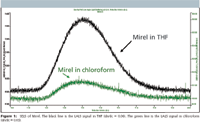SELS - Solvent Enhanced Light Scattering
Viscotek has been a strong advocate of good chromatography as a prerequisite for GPC (Gel Permeation Chromatography) data accuracy. Our recent work in application development has been driven by extremely difficult samples from industrial, biopharmaceutical, and academic sources. These samples present challenges ranging from sample solubility, column adsorption, as well as detection issues. This report will attempt to highlight a new approach that could be very helpful in certain advanced GPC applications.
Wei Sen Wong1, Chris Mirley2, and Sean Daughtry2,
1Viscotek Corporation and 2Metabolix
Viscotek has been a strong advocate of good chromatography as a prerequisite for GPC (Gel Permeation Chromatography) data accuracy. Our recent work in application development has been driven by extremely difficult samples from industrial, biopharmaceutical, and academic sources. These samples present challenges ranging from sample solubility, column adsorption, as well as detection issues. This report will attempt to highlight a new approach that could be very helpful in certain advanced GPC applications.

Figure 1
SELS emphasizes the separate and different roles of sample solvent and mobile phase in a GPC analysis where the two liquid mediums can be synergistically applied to solve a variety of chromatographic problems. This is a break from tradition where most GPC analysis would involve a single solvent for sample prep and as the mobile phase. In SELS, one could choose the best solvent for a set of samples in term of solubility. On the other hand, users can also maximize detector sensitivity, particularly LS, by choosing a mobile phase that would provide the highest dn/dc values for the samples. Because of the much larger volumes required for the mobile phase, material cost, and HS&E properties could also be important factors. Finally, column-sample interaction can also be moderated through proper selection of the mobile phase. In general, SELS is rapidly becoming a significant parameter in GPC method development.
The following is an excellent SELS example where we have applied this technique to a Polyhydroxy Alkonate (PHA, Trade Name Mirel) material. Mirel is a family of biobased, sustainable, and biodegradable plastics that are environmentally responsible alternatives to a wide variety of petroleum-based plastics. Mirel production reduces the use of fossil energy by more than 95% and provides a 200% reduction in greenhouse gases compared to production of conventional petroleum-based plastics. Mirel bioplastics can also harmlessly biodegrade in a broad range of environments including: soil, home compost, industrial compost, wetlands, and the ocean at the end of their useful life. Metabolix is currently producing an injection molding, sheet and blown film grade, and focusing on short term applications such as: compost bags, horticulture and agriculture, business products, packaging, gift cards, and electronic components.
Mirel presented an interesting challenge to the Light Scattering GPC measurement. While Mirel is Chloroform soluble, the dn/dc of this material is very low in Chloroform. It is important to increase the dn/dc value in order to get better LS response. This can be achieved with a lower refractive index mobile phase like Tetrahydrofuran (THF). However, this PHA polymer is not soluble in THF. Using the SELS concept, we combine of the solubility capability of Chloroform and the Enhanced LS response offered by THF in one single experiment to maximize the accuracy and the reliability of the analysis. The following overlay of the Low Angle Laser Light Scattering (LALS) responses of Mirel in THF and Chloroform clearly shows the power of SELS. Typical dn/dc values in these two solvents are also given.

Viscotek Corporation, a Malvern company
15600 West Hardy Road, Houston, TX 77060
tel. (281) 445-5966, fax (281) 931-4336

The Benefits of Custom Bonded Silica
April 1st 2025Not all chromatography resins are created equal. Off-the-shelf chromatography resins might not always meet the rigorous purification requirements of biopharmaceutical manufacturing. Custom bonded silica from Grace can address a wide range of separation challenges, leading to real performance improvements. Discover more about the latest innovations in chromatography silica from Grace, including VYDAC® and DAVISIL®.
5 Things to Consider When Selecting a Chromatography Silica
April 1st 2025Particularly in the pharmaceutical industry, drug purity isn’t just a goal – it’s essential for achieving safety, stability and efficacy. However, purification is easier said than done, especially with challenging molecules like DNA and RNA “oligonucleotides,” due in large part to their diversity and the range of impurities that can be generated during production. Enter DAVISIL® chromatographic silica, with a wide range of pore diameters and particle sizes to meet your specific application, performance and sustainability requirements. Before you choose the chromatography resin for your next purification application, take a look at these 5 considerations.
Automating Protein Purification: Efficiency, Yield, and Reproducibility
March 27th 2025Recent advancements in automated protein purification stress the importance of efficiency, scalability, and yield consistency. This eBook compares different purification platforms, highlighting their impact on downstream applications and demonstrating how automation enhances throughput and process control.
MilliporeSigma: Ultrapure Water for Sensitive LC-MS Analysis of Pesticides
March 25th 2025The aim of the study was to illustrate the efficiency of Milli-Q® water purification systems in eliminating pesticides from tap water, thereby producing and delivering reliable and consistent-quality ultrapure water suitable for pesticides analysis















